
Software Review
July 1, 2002
Boris Graffiti 2.0
Integrated 2D and 3D Vector Title AnimationBy Boris FX
System support: Mac OS 9.1 and OS X
Regular Price $495
FCP 3 Owners Special Price $249Review By Ken Stone
When you install Graffiti 2 it actually is installed as two different items. It's installed as a plugin for FCP, accessible from inside FCP like any generator. It is also installed as a stand alone application called KeyFramer. In addition, Intelligent Assistant for Graffiti is also installed, more on Intelligent Assistant later.So what is Graffiti? Good question. Most importantly, Graffiti is 'Vector' based. It is billed as an "Integrated 2D and 3D Vector Title Animation" application, but it truly is much more. This is an extremely powerful animation program. While animating text lies at it's core, it can accept all types of media including art from outside applications like PhotoShop, anything can be animated, not just text. As shown below, I have superimposed a cube shape onto a sunset background. I mapped six different stills onto the six sides of the cube. As the clip plays, my cube tumbles, spins and rotates on a motion path through 3D space, showing the images on each face as the different sides come into view. The screen shot taken from the Canvas window does not show the clarity of the images. For me personally, the most impressive thing about Graffiti is it's motion capabilities. When rendered out in FCP and displayed on NTSC, it's motion is smooth, sublime.
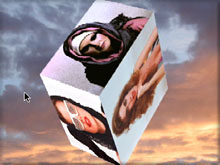
Okay, Graffiti is a Title animation application so lets look at text. Because Graffiti is processor intensive and also can provide ram preview it is best to do the majority of your work in KeyFramer, the stand alone version. When you are done in KeyFramer you will save your work and then launch FCP > Graffiti and bring it into FCP, apply to the TL and render. If you want to make additional changes you can do this work from inside FCP using the Graffiti filter, all of the KeyFramer controls and abilities are available from inside FCP.
When you launch Graffiti you get a screen full of windows. Floating on the top is the text box. If you have run the Calligraphy plugins that come with FCP 3 you will recognize this text box. It is exactly the same. You can set text, change font, size and color. In addition you can add multiple drop shadows, emboss, glow and bevels. Justify left, right or center. You can also use 'word wrap', even import text from a text application.
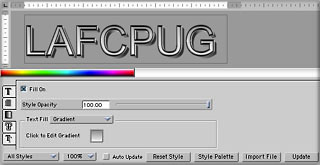
The Boris Keyframe Library Browser, which gets installed with Graffiti, is filled with a host of preset 'animated' text styles. Motion in/out, Paths, Zooms, Spins, Fades, Tracking, Particle wipes, Text transitions and many more. The Library Browser has a built in preview window so you can view these presets to choose the ones you want. You can modify and customize any of these preset effects, even save them for future use. In addition to the Library Browser there is the Style Palette which offers pre built text styles that you can use 'as is' or modify to suit your own needs.
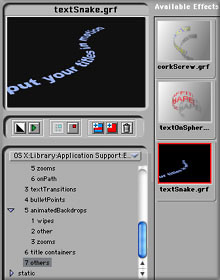
Keyframe Library Browser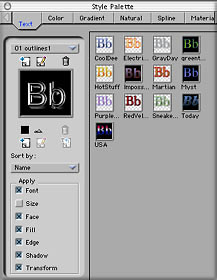
Styles PaletteWhen your type is set, simply close the Text window and the type will appear in the Composite window. For FCP users, the Graffiti Composite window is the same as the Canvas window in FCP. It is here that you work on your text, like setting motion paths as shown below. The Composite window is where you play your work to view your motion and other effects. The 'Play' controls are along the lower left of the window. There are a number of different modes that control the quality of the playback. There is also RAM preview.
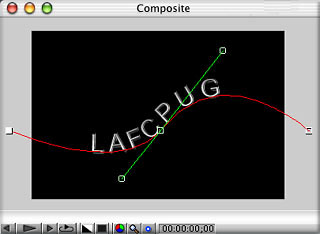
The Composite window appears in the upper right of your computer monitor. To the left is the Controls window which is contextually sensitive, that is to say the the window changes based on what type of track is selected in the Graffiti TimeLine. There are tabs along the top of the Controls window that also change based on what you are doing.
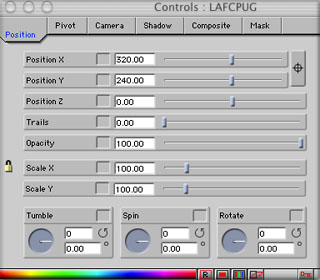
It is in the Controls window that you set all the parameters for the effects that you are applying to your text or objects. Aside from the standard motion controls, the type of interpolation for your motion is set here as well as; Pivot, Camera, Shadow, Composite, Mask, Paths, Type on, Texture, Velocity, Backdrop and others.
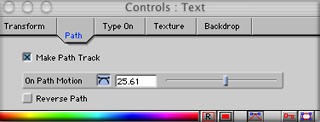
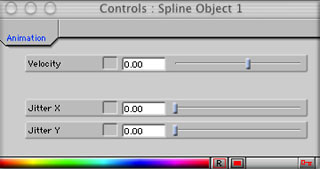
Across the bottom of the screen is the Graffiti TimeLine and it's here that the real differences show between NLE applications and Graffiti. Top left of the TL are a number of buttons that allow you to add; audio, movie, image, gradient, natural, spline primitive and backgrounds. There are buttons for blur, particle, noise and distortion filters as well as buttons for adding containers, text pages, vector and extruded 3D text.
Left hand side beneath the buttons are the many TL tracks generated by Graffiti for the various elements of your composition. There are different types of tracks depending on what you are doing. It is in these different tracks that you set your Keyframes to control the parameters of your effects. You can also group different elements together into Containers and then apply effects to the container once which will effect all the elements that are inside the container, not unlike 'nesting' in FCP.

It is here, in the Graffiti TL that it all happens. As you can see in the TL above, I have set only one line of text 'LAFCPUG', yet there are multiple tracks that belong to that one line of text. Each track represents a different aspect or parameter, each tracks behavior is Keyframeable. Keyframing is similar to FCP, move the playhead, called the CTI (Current Time Indicator) in Graffiti, to the position you want a change to begin. Select the track you want to keyframe and make the change in the Controls window. Graffiti will automatically set a new keyframe for you. You can set many of the parameters for a track right in the TL as well as using the Control window. Each time you set a keyframe you can set the interpolation for that keyframe. Interpolation types include; Hold, Linear, Accelerate, Decelerate, Ease in/Out, Constant and None. Interpolation works very well in Graffiti and contributes to the very handsome motion that Graffiti produces.
Boris list of Graffiti Features.
- Animated Text on a Path allows you to move text on a path. Both the path shape and the text position on the path can be animated over time. Create paths directly in GRAFFITI or copy paths from Adobe Illustrator.
- Type-On Text allows you to create complex effects where individual characters fly, spin, fade, zoom or shuffle on or off screen. Progressively apply parameters such as skew, tumble, spin, rotate, scale, opacity and position.
- Extruded Text create true 3D text with reflection mapping. Map textures to surfaces or apply custom materials with precise control over material properties. Simulate glass, aluminum or other materials. Easily animate text in 3D space. Multiple cameras are available for extruded text.
- Natural Media allows you to create procedurally-generated textures including wood, fabric, stone, reptilian skin fractal noise and random colors. Use materials as backgrounds or map to the faces of 2D or 3D text.
- Export to Flash or QuickTime to easily integrate titles into web designs.
- Title Containers build on Calligraphy's functionality with one click rolls, crawls, fades, shuffles, and zooms.
- Convert to Container allows you to easily transform a text track into a container with a separate track for each individual character. This allow you to simultaneously animate individual characters (at the track level) and animate the entire text (at the container level).
- Spline Primitive Vector Media creates text backdrops in customizable supplied shapes including rectangle, hearts, stars and more. Text backdrops automatically resize to fit the typed text. You can also use the spline shapes as dynamic animation elements.
- Advanced 3D Compositing includes XYZ positioning of 2D and 3D titles and shapes with multiple lights and shadows as well as motion blur. Multiple lights per layer can be specular, spotlight or light sweep. The Composite Tab lets you animate and combine 27 Apply modes for more control. 3D Containers let you group multiple tracks.
Learning Graffiti
Graffiti does have a steep learning curve. The most important concept to grasp is the 'multi track' workflow found in the TL. The idea that there are different types of tracks; Text, Transformations, Text Path, On Path Motion, Face, Mask Spline, etc and that different tracks are nested into yet other tracks takes some getting use to. In a complex composition that involves many attributes, there can be a large number of tracks to deal with.
I found the manual that ships with Graffiti to be lacking. Basic concepts are not discussed. Some of the terms that Graffiti uses are not defined and some of the 'on screen' controls are not shown or explained. This can be very frustrating. There are several tutorials at the Boris web site that give some additional information and do help, but the information is scattered about.
When you install Graffiti 2, 'Intelligent Assistant for Graffiti' is also installed which provides a 50 page trial demo. I have IA (DV Companion) for FCP and it is an excellent product. Unfortunately for me I am running OS X only and IA for Graffiti is, for now, OS 9 only. I am sure that if I had access to IA for Graffiti that my learning experience would have been much better. If you are running Graffiti in OS X and have OS 9 on your Mac you will be able to use IA for Graffiti. This from the people at IA.